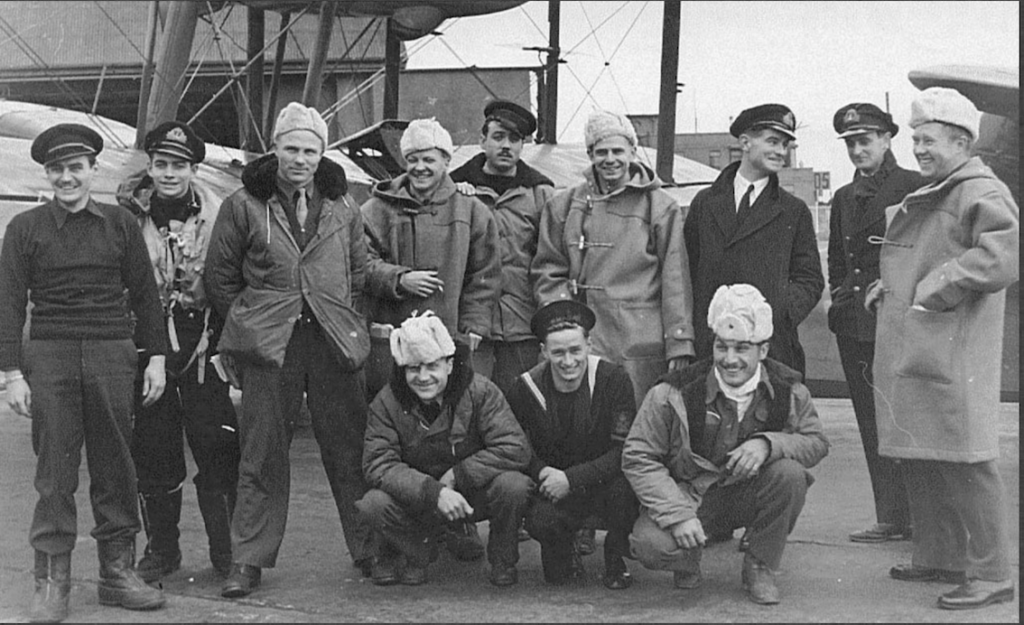
Those present include Left to right back row: Lt. George W. Ambrose, Peter Roccia & Robert Redhair
Front row : second from left, George W. Henderson Wilford L. Bollinger, Charles M. Wilson and far right James J. Heddleston.
INTRODUCTION – THE MAN WHO SHOULD HAVE BEEN ABOARD
On the night of 27/28 April 1944, the B-24 Worry Bird failed to return from its mission to the LACKEY 3A drop zone. The aircraft came down in the hills above Saint-Cyr-de-Valorges, and among the names that should have appeared on its final crew list was that of Staff Sergeant Wilford L. “Bill” Bollinger.
Bollinger was a member of the Ambrose crew, trained as a dispatcher and experienced in the demands of clandestine supply operations. Under normal circumstances, he would have taken his usual position aboard the aircraft.
But he didn’t.
The surviving administrative records show that Bollinger was sick — possibly in hospital — and unfit to fly. His place was taken at the last moment by Sergeant Cyril Mooney, who flew in his stead.
This unremarkable wartime substitution shaped two very different outcomes. Mooney flew into the mountains above Saint-Cyr-de-Valorges. Bollinger did not.
The Story
HARRINGTON – THE CARPETBAGGER PERIOD
Before illness intervened, Bollinger had already accumulated a substantial period of special-operations service at Harrington, then home to the covert units of the 801st / 492nd Bomb Group, the Carpetbaggers.
With the Ambrose crew, he flew four operational night missions delivering supplies to resistance groups in occupied France. On what should have been their fifth operation together — the mission to LACKEY 3A — Bollinger was down sick and declared unfit for duty. His dispatcher position was filled by Sergeant Cyril Mooney, who was one of only three survivors that night from the Worry Bird.
After recovering, Bollinger remained with the group and completed a further eleven missions with other crews, continuing the routine of clandestine night-flying operations.
Alongside these sorties, his time at Harrington is marked by a sequence of administrative entries recorded in the Special Orders for Station 179:
-
11 May 1944 — Temporary Duty to Ringway
A period not to exceed seven days. Ringway was the principal parachute and special operations training centre, indicating further specialist instruction or liaison duties. -
1 July 1944 — Promotion to Staff Sergeant
Under AR 615-5, formal recognition of his experience and responsibilities. -
15 July 1944 — Temporary Duty to Leuchars
Sixty days at Leuchars in Scotland, then an important hub for Air Transport Command operations. -
Early August 1944 — Administrative Transfers
Orders under PAC TWX A-171-C and SO #473 HQ 8th Air Force show his movement between the 850th and 857th Bomb Squadrons, reflecting the internal reorganisation of the Carpetbagger and associated special-operations units during mid-1944.
On 15 July 1944, Bollinger was formally transferred to the European Wing, Air Transport Command, bringing his Harrington period to a close and beginning a new phase of his wartime career.

Those present include Lester M. Schick (Observer), Pritach (UK Pilot), William C. Jesperson (Engineer), Albert L. Sage (Radio Operator), Robert C. Durham (Navigator), David H. Schreiner (Pilot), Albert L. Krasevac (Gunner), Neil G. Richards (Gunner), together with two unidentified U.S. officers and two unidentified UK officers.
Wilford L. Bollinger (Dispatcher) is 4th from left back row.
AFTER HARRINGTON – A DIFFERENT WAR
Bollinger’s subsequent service placed him within Colonel Bernt Balchen’s Air Transport Command detachment, operating from Leuchars. These missions were discreet, often flown in aircraft painted in civilian grey, and nominally concerned with industrial consignments. In practice, they frequently carried resistance personnel, intelligence material, or other sensitive cargo.
Although Mosquitos were sometimes employed within the detachment, Bollinger himself had no operational role connected with Mosquito flights.
The most notable episode of his later service occurred on 20 September 1944 during a resupply mission to the Norwegian underground. After the drop, the aircraft developed engine trouble and diverted toward Murmansk. Passing low over the Soviet battleship Arkhangelsk, it was mistaken for an enemy aircraft and fired upon.
The pilot, Lieutenant Colonel Allen, was killed. Bollinger and the surviving crew parachuted to safety, were interned for two weeks by Soviet authorities, and were eventually repatriated via the Royal Navy through the Shetland Isles.
Bollinger survived the war.
Sources and References
- Special Orders, Station 179 (Harrington), May–August 1944 — temporary duties, promotions, and transfers for W.L. Bollinger.
- 801st/492nd Bomb Group (Carpetbagger) crew rosters and mission participation summaries.
- Records of the European Wing, Air Transport Command, including operations from Leuchars under Col. Bernt Balchen.
- Reports relating to the Murmansk incident of 20 September 1944.
- Worry Bird mission documents for 27/28 April 1944, noting Bollinger’s illness and replacement by Sgt Cyril Mooney.
- Private research files: mission logs, personnel notes, and correspondence relating to the Ambrose crew and Station 179.
